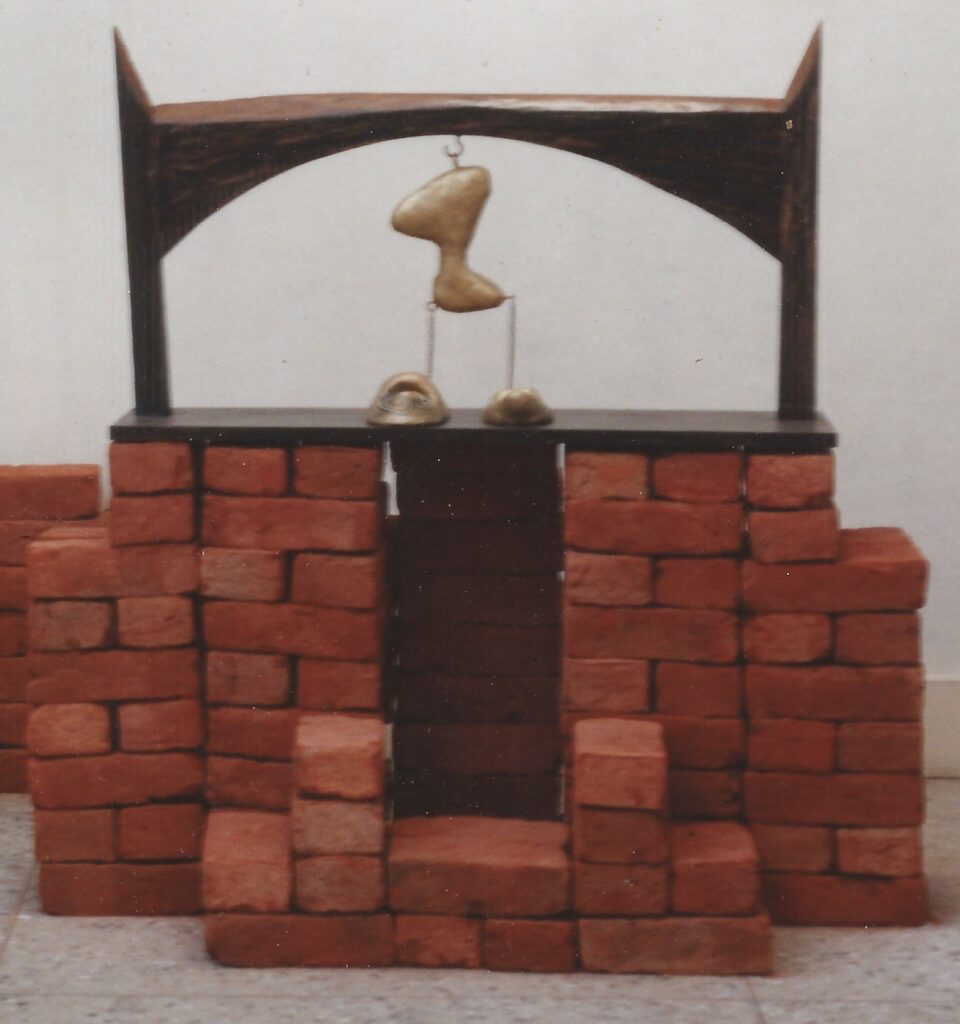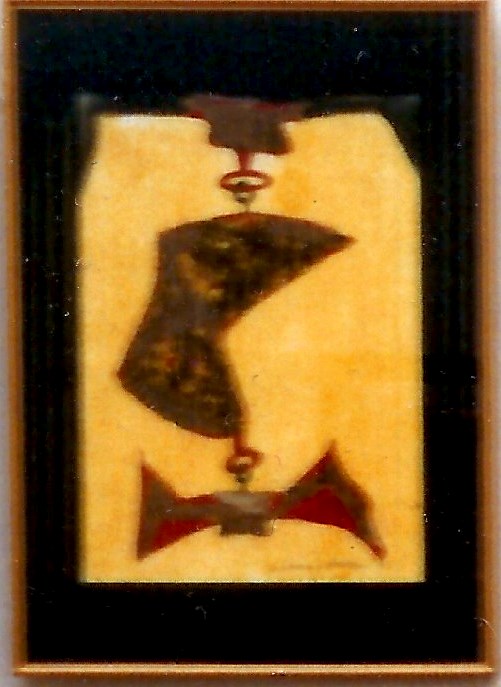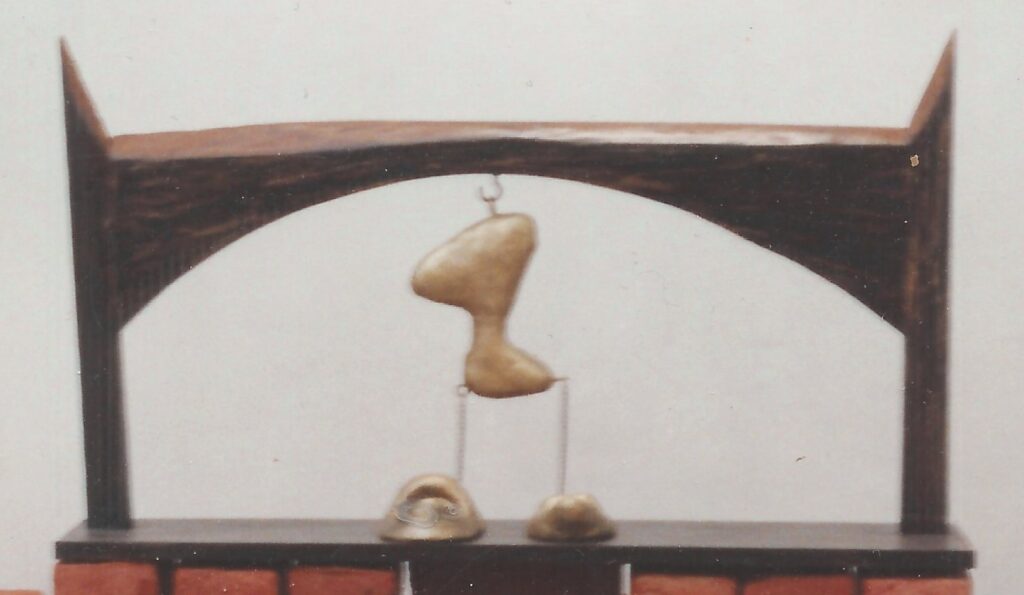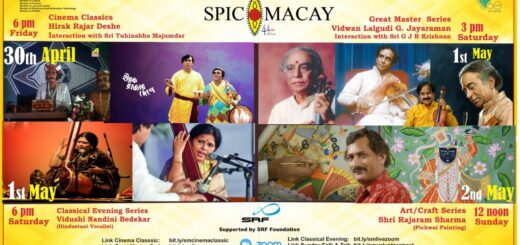The X factor of Installation Art/Archana Hebbar Colquhoun
Installation Art
I would like to quote from the Tate glossary of art terms a definition of Installation Art.
“Mixed-media constructions or assemblages usually designed for a specific place and for a temporary period of time”
This definition is broad, succinct and most suitably describes many of my installation works. One example is the Altar, an installation work in which I bring together paintings, sculptural works in wood and brass, bricks, and a temple bell that I displayed at a gallery in New Delhi, as a single work.

However, the presentation features of an art installation allow an artist to mix and match artworks and objects and present what might be a hybrid collection of works as one homogenous whole. The arrangement and display of the works and objects are designed by the artist (not by a curator) and the completed assemblage would result in a new, composite work – an art installation bearing the name of the artist as its creator.
Installation art throws up rich and exciting possibilities for artistic expression.
I would like to present a descriptive analysis of the installation work titled Altar. The installation consists of four discrete components: the centrepiece; the pedestal; the paintings; and a temple bell.
The Centrepiece – a Torii gateway with Obstacles
The main component of the installation, the centrepiece, is a Torii gateway with chained objects suspended from the top-centre of the gateway; the objects acting as an obstacle to entry.
The main advantage of installation art is that an artist can create multiple works of “installation” using the same set of (art) objects by assembling them in different compositions and playing around with the placements of the objects. The possibilities for innovation are virtually limitless. The centrepiece of the present installation consists of four detachable pieces: the Torii gateway and three small brass sculptures, connected by chains – acting as an obstacle.
The obstacle consists of one main part – a Z-shaped form and an auxiliary part – two forms resting on the base of the Torii gateway connected on either side by a chain to the suspended Z-shaped form. The two forms (not clearly seen in the featured photograph) are sculptural expressions of a slipper and a footprint in 3D form. The three forms (of a hand-held size) are in fact three independent sculptural works, which can be displayed individually or in combination with other related works.
[Note: I made a series of small sculptural works, cast in brass, all of which can be connected to one or more works, interchangeably, using chains. A discussion about these works would form the subject of a separate article.]
The Pedestal
The centrepiece, the Torii gateway, rests on a dry wall of bricks, within which is a niche acting as the sanctum sanctorum of a temple with an architectural feature of a step leading into the small, vertical hollow in the wall.

Sculptural works, unless very large, are always placed on a pedestal in a gallery setting. The use of a brick construction instead of a wooden pedestal box to display the Torii sculpture opens up the meaning of the work (consisting of the Torii and the brick wall) since the pedestal becomes a part of the work. The brick wall, on which the Torii gateway is placed, can be seen as depicting sacred architecture that has a sculptural component, the Torii. If the Torii was placed on a wooden display pedestal instead of a brick wall it would be seen as a (simple*) work of sculpture.
The brick wall plays a transformative role in terms of meaning and construction within the installation.
* I use the term “simple” not as a qualitative description of the art of sculpture but as a depth of vision employed in reading a work of art.
[Note: The bricks used in this installation are common burnt clay bricks made and used in India for constructing houses and other small buildings. The bricks are backing bricks (as opposed to facing bricks – used as a veneer) and they require rendering with mortar to hold them in place and need plastering once a wall is built.
The dry brick wall on which the centrepiece of the present installation rests can easily be taken down without damaging the bricks and the bricks put to use for which they were made originally. The bricks in the dry wall in the installation do not sit flush on and against each other as no mortar is used to build the wall.
Paintings of Torii gateways with Obstacles
I explored further the subject of the main (sculptural) component of the (Torii gateway) installation in paintings. The two paintings hanging on the wall, above the centrepiece, one to the left are from a series of paintings the idea for which came to me after I had done a body of Torii sculptural works. The paintings are of a slightly later date.

The main subject of the paintings is the two-part form of an “obstacle.” Although the form of the Torii no longer appears in the paintings the top edge of the painting is suggestive of the existence of a Torii gateway.
The paintings are self-explanatory, except that they are titled “Herbal Paintings” – an entirely new category of works. As I continued to explore the theme of the “Torii with obstacles” in a 2D medium the principal focus of the works shifted to the pigments I chose to use in making the paintings. The subject matter of a Torii with obstacles that was the source of the paintings became incidental to the painted works, a mere vestige of an earlier idea.
The pigments used in the paintings are turmeric, kumkum, henna, and kaajal (organic eyeliner paste).
[Note: Turmeric and the red kumkum powder are indispensable to any ritual performed in a temple, and are considered sacred.]
A Bronze Temple Bell
The presence of the temple bell in the installation not only points to another series of works titled “Sound Sculptures” but also transforms the meaning of the installation, just as the brick wall does.
Many of the small sculptural works described earlier in the essay (the obstacles in the Torii) are in fact examples of sound sculptures. When the original clay or plaster forms of the sculptural works were cast in brass I asked the artisan to place a tiny stone inside the hollow of the brass works so as to create a sound (as does a child’s rattle) when the object is picked up by a viewer for closer inspection.
The fact that these brass works incorporate the element of sound is not evident unless a viewer is already familiar with the works. The bell acts as a connecting thread to the sound element hidden in the brass sculptures.
The (hybrid) collection of works featured in the installation present a meaning that is concentric.
The temple bell with its definitive meaning provides a trajectory through which the viewer comes to see the installation as one that represents sacred space.
The temple bell and the bricks are two components of the installation that are obviously not made by me. This is one advantage of installation art where works and objects not made by the artist can be presented in a 3D assemblage along with other works without the artist being accused of misappropriation.
There is no possibility of doubt in the viewer’s mind as to the origin and identity of the temple bell and the utilitarian bricks, both of which are integral to the installation.
Conclusion
The works and objects of one installation can be presented in a different combination in another installation and context. In one installation the same set of objects can be displayed in a grouping that is intended to convey one primary meaning but when presented in a different combination (irrespective of the display space) the installation could express a statement that could not be read from a construction of an earlier installation, which consisted of the exact same set of objects.
For example, if the temple bell was not hung above the centrepiece but placed on the floor, upright or on its side, it would change the meaning of the work, almost entirely.
A number of other issues to be discussed and clarified with respect to this installation arise in my mind, although the essay has now come to its end.
No writing on an artwork can and will be conclusive.











What was most interesting to me about your installation were the ‘obstacles’ that you define. While the presence of the paintings, bell, brick structure tell of the sacred, I was wondering whether the ‘obstacles’ were hinting at absences. What I mean is whether or not they would remind us that sacred spaces of certain kinds excluded social groups from time to time. There were other ‘obstacles’ too. Who was entitled to perform in the sacred space? Would the brick structure then be an inhibiting space while the bell is metaphorically calling all to swing it to make their presence felt.
Some of my instinctive reactions to an installation that captures our attention.
Aloka, thank you for your probing question about the obstacles referenced to in my work. It has opened up the enquiry within my own mind as to what the obstacles in the gateway mean to me.
Taking the idea at its most elemental I would say that the obstacles could refer to the everyday grind of life as well as the periodic crossing of thresholds, overcoming hurdles during the course of a person’s life journey. A rite of passage is often a painful and a challenging experience that is life transforming.
But the two points you make lit up something in my brain – one is of an abstract, metaphysical nature and the other the subject of a larger social, anthropological inquiry.
I’ll take the first one that of “absence.” How obvious it is now that you point it out. Of course, the emptiness within the frame of an entranceway is a negative space, a sort of a void that needs to be filled. Speaking from a psychological or behavioural point of view we often throw obstacles in our own path to create impetus for taking action, which makes the living of life a meaningful act.
Obstacles are both those thrown in our path of progress by an external agent as well as ones created by the self.
The second point you raise that of “exclusion” through an obstacle being placed at the point of entry or a brick wall constructed to create a division of space to keep the “other” out is a thought that’s been troubling me ever since I was a child.
Being born in a Brahmin family makes you aware of these issues at a young age. Even within a family of Brahmins the women are rendered untouchable and excluded from events at maddeningly regular intervals; leave alone the different forms and levels of exclusion of other social groups that we witness silently but against which we take no action.
The last point I would like to make in relation to your comment is that by placing the “obstacles” within the context of the sacred, i.e. the Torii gateway to a Shinto shrine, the primacy of meaning of the work perhaps shifts to the realm of social anthropology rather than metaphysics.
Enjoyed seeing the Art ‘arrangement’ as well as Archana’s eloquent and educational commentary.
The Torii painting using the vibrant hues of turmeric, kumkum and kajal is pretty spectacular. I liked it very much by itself as well as in the context of the entire meditative (sacred space) assemblage! -Iffat, New Jersey, USA.
Thank you for the comment Iffat.
I am glad you noticed the vibrancy of the colours in the paintings. When I decided to use turmeric, kumkum, and henna as painting materials, I was not certain how long the pigments would maintain their vibrant and dense colours. The paintings are more than 25 years old and the colours are just as bright as when I first used them.
I also liked the fact that you made the connection between the pigments used in the paintings and the context of a sacred space.
Complex but intriguing and interesting. I found the sound sculpture bit and the herbal painting bit novel, where the medium takes primacy over the image because you title it that way (with another name, the medium would not have attracted any attention). Also there is an element of artistic expression kept hidden until coaxed out like the stone in the brass. If there is some way that the temple bell would ring on its own and the brass sculptures given a vigorous shake to make the sound, the viewers would know it.
I enjoyed reading your comment, especially because you raised the point about the rationale behind the title “Herbal Paintings.”
The meaning lying hidden within the enmeshed inter-relationships between the works was only alluded to in the installation and my text provides only factual information such as the pigments used in the paintings and the element of sound incorporated into the brass sculptures.
These two points come to mind:
1. A temple bell, even without it ringing, clearly points to the fact that it is an object whose singular purpose is to create a sound.
2. The element of surprise is central to the idea behind the sound sculptures. This point requires a dedicated discussion in a separate article.
I’m just an Engineer to the core with no understanding of art, whatsoever. However, as I know about Archana, I’m daring to comment here. So my views won’t carry any meaning.
As I said, I don’t understand art, but when I read all the analysis, I’m surprised that so much meaning lies in those few pieces and so much thinking has gone into putting them together. On the first look, even for a lay person like me, and before reading all the explanations, it did convey some sort of old templish kind of impression to me – like the old worn out temples you see in India. At first look I thought why use those ugly bricks and that too not placed in a gapless manner. But after reading it it starts to make sense in a way.
The work is of course not something that, if you pass it by, will go without raising curiosity or some thoughts in your mind. If that’s part of the purpose, it does fulfill that.
Most of the time, like a typical engineer, I keep searching for a purpose that the art work is supposed to achieve – which I generally don’t understand. If the purpose is to convey to the viewer that it looks like an ancient temple kind of thing, then to that extent the purpose is served.
Nevertheless I’m now bit more enlightened by the deep analysis given by Archana. Next time I look at some art, I may think of it a bit differently, perhaps.
Thanks for the education, Archana
Thank you Praveen for the comment.
It’s honest, truthful and brings in a different point of view without moving away from the central message of the work and the writing.
You were able to see in the work a reference to one of those little wayside shrines, often in a state of disrepair – not always maintained as they could be due to lack of patronage by the wealthy.
You raised a point about the brick structure.
The brick platform wall served a clear purpose in the installation, but I do share your feelings of (a slight bit of) dissatisfaction about the roughshod placement of the bricks. (Refer to the note in the article about the bricks.)
If, however, had I used machine-made, facing bricks that sat flush against each other to construct the brick wall pedestals, which would appear neat and tidy, it may very well have interfered with the meaning of the installation.
The materials used in an artwork play a significant role in conveying an intended meaning.
I may have my own interpretation and my own response to this art work, but I did find it interesting to read the artist’s intent and interpretation – particularly when it is articulated so clearly and effectively. Yes, I do believe in trust the tale not the teller, and I agree I could perhaps now see it a bit differently being somewhat influenced by the artist’s writing. Yet, I’m fascinated by the artist’s process, including thought process, in their creation. I’m intrigued by the visual art (can’t hear the sound) and enjoyed the writing as well. Fascinating work, Archana.
Thank you for the feedback. I found many points of interest in your comment. The point about “sound” that cannot be heard and only inferred from the presence of the temple bell and definitely no sound being heard or even expected to be heard from the little brass sculptures is a valid point of discussion.
I plan to write a short piece about my “sound sculptures” and whether sound is even a necessary part of those works; or is it just a playful act of creating new associations between unrelated entities.
Lastly, it would be interesting to know what your interpretation is of the work.
Beautifully written and describe about the installation of art through your own work. When I read your writings that’s truely very strong than your own works, may be the art practices need such a full time involvement steadfast.
This is my personal opinion.
Thanks for sharing.
Madan Lal Gupta
Thank you. That’s very perceptive. Art writing can sometimes become an end in itself. Often, artworks are just a starting point for a critic to present their ideas. In this case, however, the artist and the art writer are one and the same. The question is should artists write about their work or leave art writing to critics. I am interested in the interplay between the two disciplines.
I see your point Archana Hebbar. Generally artists need critics to give them the viewpoint of the viewer. Often artists are unable to express themselves in words, though they do so very well through their art, which is more important. However if an artist can express herself both in words and in form, then it is more interesting, because they can debate or agree with the critic, also they can put their point of view, and viewers can decide whether, they agree or not. But there is a corollary, there I tend to see Madan Lal’s viewpoint. Artist must write about her work only after the exhibition is over and all reviews have come, because the beauty of an art form lies in it communicating on it’s own. Sometimes words can distract from the abstract messages.
A clarification
The installation was presented in an exhibition nearly 25 years ago and reviews of the exhibition by art critics from different newspapers already exist and are still available.
Art exhibitions usually come with a catalogue with an introductory text and other relevant information on the works featured in the exhibition. The catalogue may even include a statement from the artist.
The purpose of this essay is to throw light on some aspects of installation art and to demonstrate how meaning is created by a particular combination of works within an installation and to do this I have taken one of my works as an example. The issue perhaps may be whether the writing is of a higher standard than the artwork itself, since I started my professional career as an art critic and not as an artist.
This particular installation lends itself to the central argument of my essay. I consider this installation to be a perfect diagrammatic representation of the ideas presented in the essay.
However, it goes without saying that it is always an enriching experience to hear other points of view on one’s work, since no work is complete in itself.